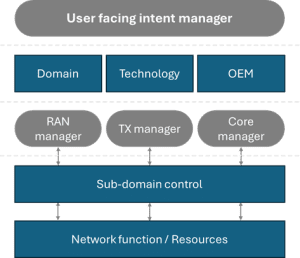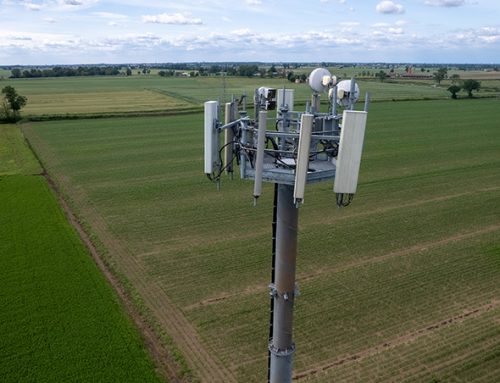Introduction
As modern businesses navigate an increasingly complex network landscape, the limitations of traditional network management solutions like Self-Organizing Networks (SON) and RAN Intelligent Controllers (RIC) are becoming evident. Intent-based networking’s (IBN) advanced capabilities in business intent alignment, automation and real-time analytics position it as the future of network management, driving innovation and efficiency in an increasingly complex network landscape.
What is Intent-Based Networking?
Intent-Based Networking (IBN) translates high-level business intents into network policies and configurations using AI and machine learning. This approach automates and optimizes network operations, ensuring they align with business objectives.
An intent-based networking system offers organizations a lot of benefits, including –
- Alignment with Business Goals: IBN translates high-level business intents into network configurations and policies, allowing for dynamic adjustments that support strategic goals.
- Proactive Network Management: IBN anticipates traffic spikes and adjusts resources ensuring seamless connectivity and optimal performance during peak usage times. It leverages AI/ML to continuously analyze network conditions and predict potential issues before they impact performance.
- Self-Optimization and Resource Efficiency: IBN uses continuous monitoring and real-time analytics to adjust power levels dynamically, optimize signal paths, and balance loads across the network. This reduces energy consumption, extends the lifespan of network components, and leads to cost savings and sustainability.
- Self-Healing for Improved Uptime: IBN incorporates AI/ML-driven self-healing capabilities that significantly enhance network uptime. It detects anomalies and failures in real time and automatically initiates corrective actions, such as rerouting traffic or adjusting configurations.

Fig. 1 – Advantages of intent-based network management
Progressing from SON, RIC to IBN
It is crucial to understand how Self-Organizing Networks (SON) and RAN Intelligent Controllers (RIC), which established the foundation for modern sophisticated network management, evolved before diving into Intent-Based Networking (IBN).
Self-Organizing Networks (SON)
SON revolutionized network management by automating tasks like configuration and optimization. For example, Vodafone used SON to enhance network performance by automatically adjusting radio parameters, reducing manual interventions, and improving efficiency.
RAN Intelligent Controllers (RIC)
RIC further advanced network management by centralizing control for radio access networks. Dish Network, for instance, utilized RIC to optimize RAN functions in its Open RAN deployment, allowing for more sophisticated and flexible management of radio resources.
Transition to Intent-Based Networking (IBN)
IBN builds on the automation foundations of SON and RIC by integrating business intent alignment with real-time analytics and AI. This shift enables networks to operate autonomously, improving operational efficiency, speeding up service deployment, and reducing costs. For instance, Cisco’s DNA platform uses IBN to automate network provisioning and policy enforcement, leading to faster and more reliable service delivery.
Aligning network management and business goals
Operators often manage multi-vendor networks that offer cost control and efficiency but are complex and prone to manual errors. By leveraging AI, machine learning, analytics, and APIs, IBN enables the translation of high-level intentions into actionable network operations.
|
For instance, a network administrator managing a large corporate 5G enterprise network must prioritize video conferencing across all network components to avoid lag or disruptions during meetings. Traditional Approach: In a traditional 5G network, ensuring optimal video conferencing quality requires meticulous manual configuration of multiple network elements, including:
This manual process is time-consuming, error-prone, and often requires deep technical expertise. As the network grows and evolves, maintaining these configurations becomes increasingly complex. IBN Approach: With IBN, the network administrator can simply define the intent: “Prioritize video conferencing traffic across the entire 5G network to deliver a superior user experience.” The IBN system then automatically translates this intent into specific configurations for all network elements, including:
IBN simplifies this process by allowing network administrators to define desired video conferencing quality as a high-level intent. The system automatically configures network elements, optimizes resource allocation, and ensures continuous performance monitoring to deliver an exceptional user experience. |
Unlike traditional programmable networks, which depend on condition-action policies and manual management of an expanding array of APIs and functionalities, intent-based networking enables users to define their ultimate goals for the network, rather than simply issuing a set of instructions in isolation.
IBN and intent-based orchestration are supported by standard organizations such as IRTF, 3GPP, ONF and ONOS, highlighting their crucial role in advancing network management paradigms.
The Role of Intent Managers in IBN
The foundational structure of an Intent-Based Networking (IBN) system consists of a hierarchy of Intent Managers. Intents concerning end-to-end (E2E) services, or anticipated E2E network behaviour are directed to an entity capable of managing E2E actions. At the top of this hierarchy is the Customer (or User) Facing Intent Manager, or the E2E Intent Manager (IM).
Intent Manager: Your Network’s Command Centre
The core module of intent-based networking (IBN) systems is an Intent Manager, which serves as an orchestrator, coordinating multiple network elements across several domains, including transport, core, and RAN, to ensure the entire network functions under the intended intentions. The Intent Manager uses AI/ML algorithms to optimize resource allocation, automate decision-making, and maintain continuous feedback loops, allowing the network to self-adjust and meet the desired outcomes in real-time.
Beneath the E2E IM is a tier of specialized Intent Managers, each responsible for specific domains, technologies, or administrative areas. This tier is essential, as it is impractical for a single entity to possess a comprehensive view of the entire system, including all vendors, technology domains, and resources.

Fig. 2 – The IBN framework
When E2E intents reach the E2E IM, they are analyzed, segmented, and distributed to the specialized IMs. While the E2E IM remains accountable for fulfilling the E2E intent, it can delegate specific aspects to these specialized IMs.
The E2E IM uses the APIs of these lower-level IMs, which, in turn, utilize the APIs of existing domain controllers, such as Radio Access Network (RAN), Transport, or Core domain controllers (e.g., orchestrators, SDN controllers), to execute the necessary actions.
As intents are broken down and passed down the hierarchy, measurements and insights are gathered and returned. This feedback loop is crucial to avoid exposing operator-level details within specific domains or resource contexts. The E2E IM thus synthesizes and presents the status of services, networks, and resources in a manner that maintains the original intent’s abstraction and terminology.
It is important to note that an intent-based system should also support more specific intents or direct configurations at the domain controller or resource level. Such requests are asked by domain experts who understand the system’s intricacies and can evaluate the implications of lower-level interactions.
Allowing these interactions is vital for accessing the full configuration space of the system, enabling quick overrides when necessary to address temporary or exceptional demands with precise configuration requirements.
Conclusion
As networks become more open, containerized, and cloud-based, and the demand for more customized solutions increases, organizations will need to focus on the following areas for successful IBN implementation:
- Designing network slices: Tailoring network slices for specific 5G use cases to optimize performance.
- 5G core integration: Aligning and integrating key components (e.g., AMF, SMF, and UPF) within the 5G core network to support IBN functionalities.
- RAN orchestration: Automating RAN management (e.g., gNB and ENB) using intent-driven policies to improve efficiency, reduce operational costs and enhance network agility.
- Network function virtualization: Deploying rapid, flexible and scalable services by leveraging NFV technologies.
- Edge computing integration: Integrating with edge computing platforms to deliver low-latency applications and real-time services.
- Security and Privacy Management: Implementing IBN-based policies to ensure secure and 5G private network communication.

























![Telco Cloud: A Key Enabler to Telco Transformation [Part 1]](https://www.tatacommunications-ts.com/wp-content/uploads/2023/06/Telco-Cloud-blog_image-1-500x383.png)




